Findings by role
How different roles experience and enable change in nonprofits
Differences in perspective, influence and confidence by role
Confidence in managing change depends as much on position as on perspective. People higher in the hierarchy tend to feel surer that their organization can keep up with the pace of change, while those closer to the front line describe a more uneven reality. This pattern runs through the data — authority, access to information and involvement in decision-making all shape how capability is perceived.
Executives and senior leaders usually see the system as a whole. They focus on alignment, resources and strategy and are more likely to believe their organization adapts well. Managers translate those ambitions into action, often balancing delivery pressures with the need to maintain morale. Specialists such as HR, communications and change leads work closest to the daily experience of transition, noticing the friction points that others may overlook. Their insight is immediate, but their confidence in the system’s overall capacity tends to be lower.
The chart on the right shows how these perspectives diverge — from high confidence among executives and project managers to much lower ratings among functional specialists. It offers a reminder that confidence is not only an indicator of capability but also of proximity to power.
Leadership clarity and support
Confidence alone does not explain the full picture. When people describe how well their organization manages change, much of that perception rests on what they see from leadership — the clarity of direction and the consistency of support. The survey data show that these signals look very different depending on where people sit.
Executives overwhelmingly believe leaders are clear and supportive, while managers and change leads report a far less coherent picture. For those tasked with implementing change, messages often arrive fragmented or late, and visible follow-through can be uneven. These gaps matter: when communication falters, so does confidence in the system’s overall capacity to adapt.
Executives and senior leaders
Senior leaders carry both the ambition and anxiety of change. They are the group most likely to describe change as well-aligned with strategy and to rate leadership effectiveness highly. Their responses across the survey show a strong belief in intent: confidence that the organization knows where it is going and why. Nearly three quarters say leadership provides clear direction, and most view their own change processes as structured or emerging rather than ad hoc.
Yet the same data reveal distance from daily realities. Executives are less likely than other roles to cite staff capacity or communication breakdowns as key challenges. From above, change looks coherent and well-directed; from below, it feels demanding and fast-moving. The contrast highlights how perspective shapes perception more than intent.
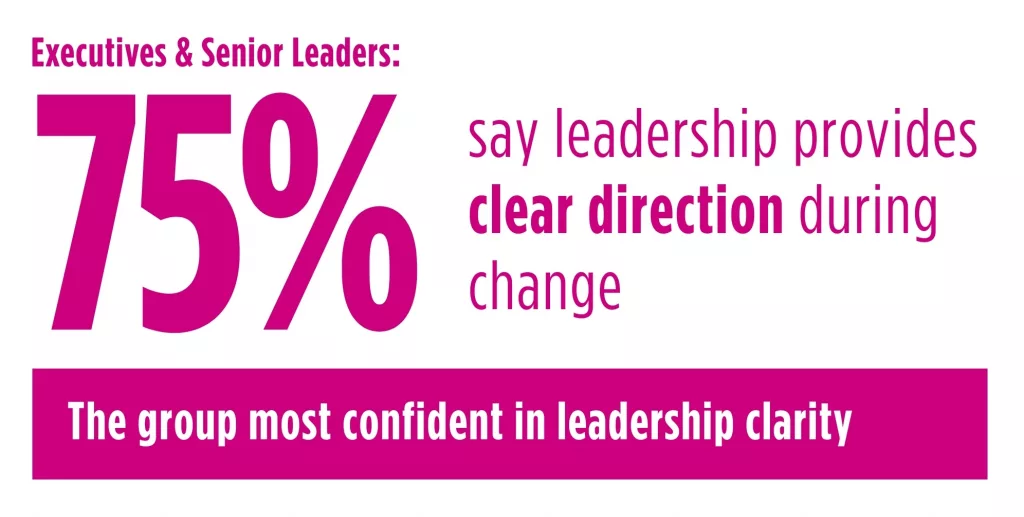
Programme and project managers
Programme and project managers work where change plans meet reality. Their confidence in the organization’s ability to keep up with change is on par with executives — around one in three describe adaptation as going well — yet their responses elsewhere show how fragile that balance can be. They are the group most likely to describe change processes as emerging or developing, and to flag resource constraints and competing priorities as major barriers.
These managers translate strategy into deliverables, bridging the distance between vision and workload. They see where alignment falters and where communication gaps slow coordination. Their vantage point combines optimism and strain: enough authority to influence outcomes, but not always enough capacity to sustain them. For many, change feels like constant juggling rather than steady progress.
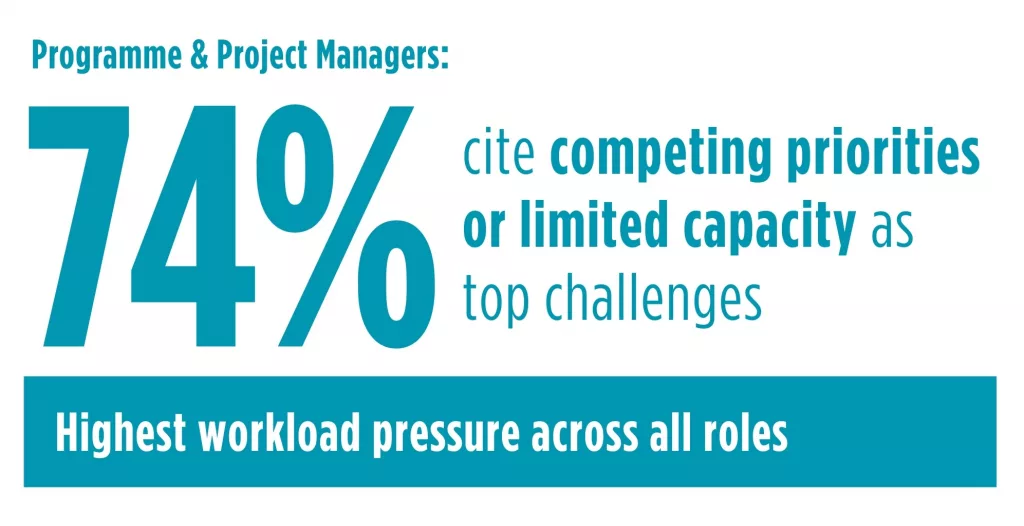
People Managers and Team Lead
Team leads and middle managers sit at the heart of organizational change — close to staff realities yet responsible for maintaining delivery. Their view is grounded in what actually happens day to day. Only about one in three say their organization keeps up well with the pace of change, and their confidence in leadership support is markedly lower than at the top. Many describe direction as uneven and follow-through as inconsistent.
The most common challenges they cite are competing priorities and lack of staff capacity. These managers absorb both pressure from above and fatigue from below, often without the time or tools to manage either effectively. Their responses portray the quiet tension of the “missing middle”: aware of what needs to change but stretched too thin to make it happen.

Change Management Practitioners
Change practitioners bring expertise but rarely authority. Their responses form one of the most consistent patterns in the dataset: deep understanding paired with limited influence. Barely one in seven say their organization keeps up well with change, and only a similar share describe leadership as clear or supportive. They recognise the mechanics of change but often lack the mandate to enforce them.
This group is also the most likely to report competing priorities, limited sponsorship and patchy communication. Many describe systems as developing but fragile — mature enough to define processes, not yet strong enough to embed them. Their confidence is less about what they can control and more about what they can navigate. The result is a paradox familiar across the sector: those most skilled in enabling change often face the greatest constraints in practising it.
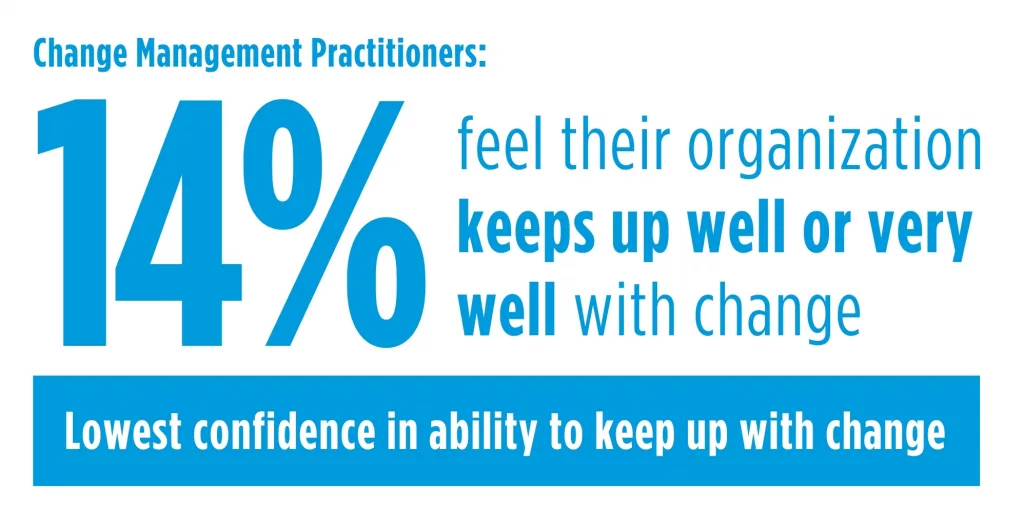
HR and organizational development professionals
HR and OD professionals see change through the lens of people systems — recruitment, learning, wellbeing and culture. Their perspective is among the most complex in the dataset: they understand the human cost of transformation yet often operate without the authority or resourcing to address it. Fewer than one in four say their organization keeps up well with change, and almost none describe their processes as integrated.
They are also among the most likely to cite lack of staff capacity, competing priorities and limited budgets as barriers. Their vantage point highlights a paradox: they hold responsibility for engagement and support but are rarely included early in strategic discussions. Many describe working reactively rather than proactively, trying to sustain morale in systems that reward delivery over development. The data point to a persistent structural blind spot — the gap between people strategy and change strategy.
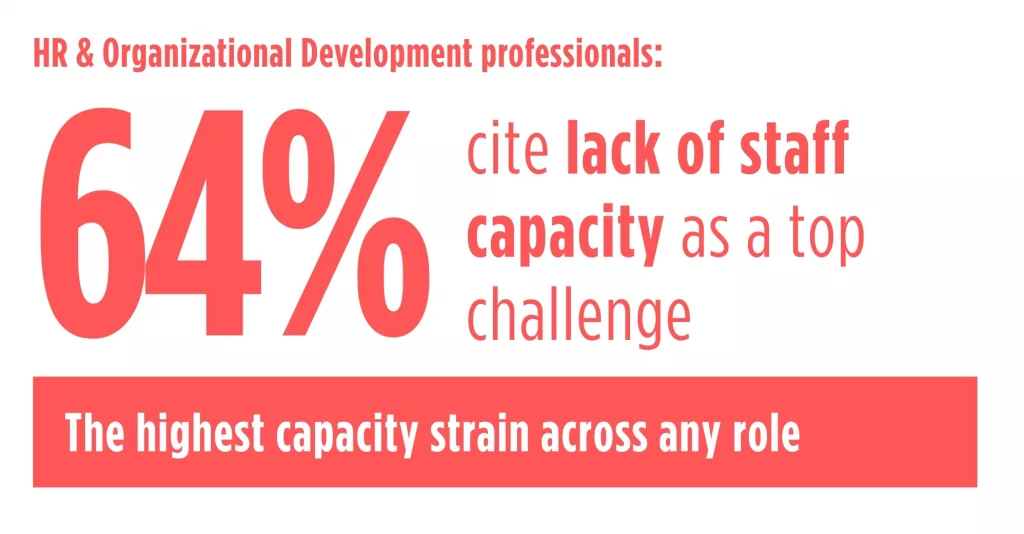
Communications and Engagement Leads
Communications and engagement specialists work at the intersection of change and perception. They translate plans into messages, turn updates into stories and connect decisions to meaning. Their responses, however, show how this role is often caught between clarity and constraint. Barely one in five believe their organization keeps up well with change, and only a small share describe leadership as clear or consistent.
This group reports the highest rates of communication breakdowns and silos, as well as heavy competing priorities. They see how messages fragment as they move through layers of approval and how alignment erodes when timing slips. The data reflect both proximity and powerlessness: those most attuned to tone and trust are often least able to influence them. Their vantage point captures what happens when communication is treated as output rather than architecture.
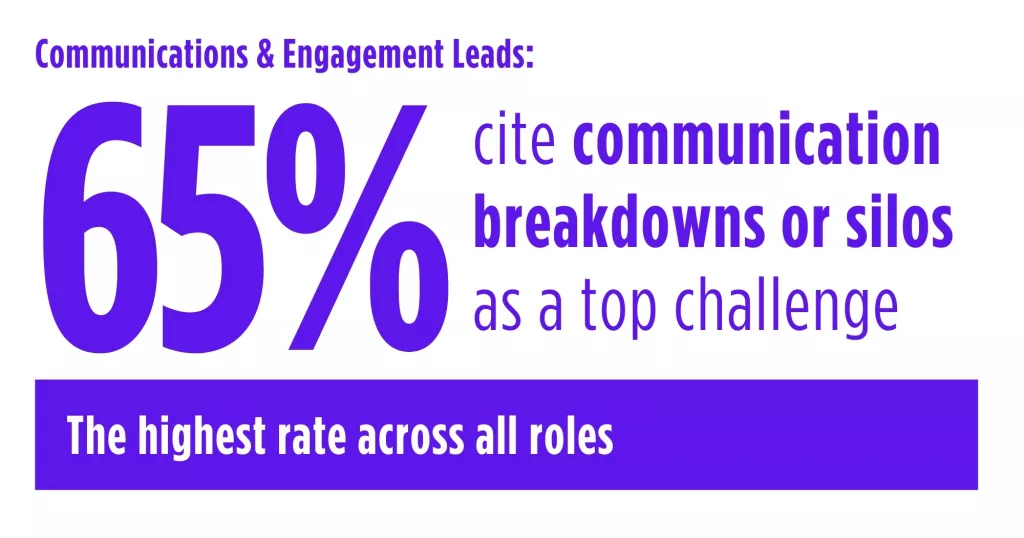
What stands out
- Executives and senior leaders report the highest clarity on leadership direction.
- Programme and project managers face the highest workload pressure during change.
- People managers and team leads show the lowest confidence in leadership support.
- HR and organizational development professionals experience the greatest capacity strain.
- Change management practitioners express the lowest confidence in their organization’s ability to keep up with change.
- Communications and engagement leads report the highest share of communication challenges.
- Together these perspectives form the system of change. Each role holds part of the picture — but alignment, clarity and pacing depend on how well those parts connect.
Looking ahead
The forthcoming State of Change Management Playbook will take a closer look at how roles interact during organizational change — exploring practical ways to strengthen collaboration between those who design, lead and enable transformation. It will also unpack what shared ownership can look like when influence is distributed across levels rather than concentrated at the top.